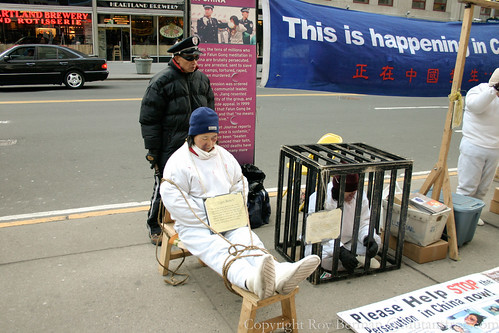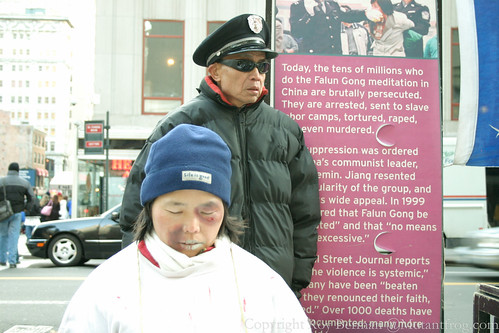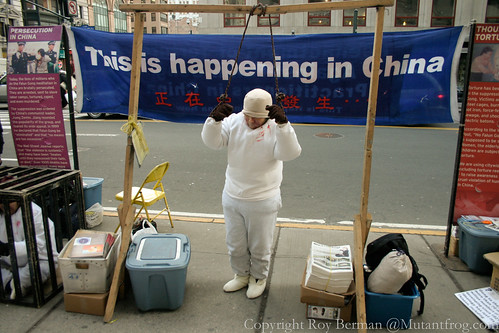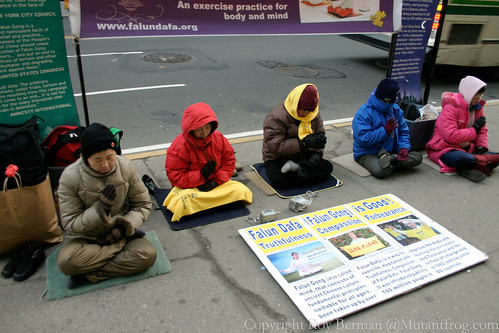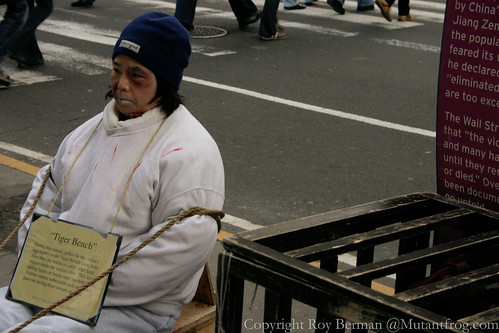I spent the new year holiday seeing the sights in Guangdong and Hong Kong. Probably the most interesting sights came from the 2-hour train ride from Guangzhou to Kowloon.
Month: February 2008
Voices of the South Carolina electorate
The following came out of the mouth of one of my parents’ neighbors:
I just don’t trust that Hillary. She’s soft on terrorists. She’s never gonna find Aladdin.
Tokyo getting more anal about dual nationality
Japan’s ban on dual nationality is less toothless than it used to be, as the government finds creative ways to keep people from maintaining multiple passports. Terrie Lloyd‘s e-mail newsletter this week quotes an unidentified source who says:
It seems that if you are Japanese and you renew your Japanese passport at your local US consulate, when you go to pick it up you are asked to show your green card or other residency documentation which allows you to be in the US. If you cannot produce this documentation, and you wouldn’t be able to if you held a US passport, they won’t hand over your new Japanese passport. Apparently this is how they are now catching dual citizens living abroad.
To avoid this, I could renew my passport in Tokyo, but if I do, I have to show them my juminhyo. That means I have to re-establish residency and live back in Japan for a few months — which of course is difficult to do when one has a career to fulfill.
Note that this particular procedure only affects people living outside Japan. Dealing with Japanese nationals resident in Japan while retaining a foreign passport is still much trickier to visualize, although with the new fingerprinting and photographing systems, anything is possible…
Jenkins book finally available in English
For those of you who have been waiting for it, the story of the famous Vietnam war era deserter to North Korea, Charles Jenkins, is finally out in English. Normally I would explicitly avoid promoting something I was notified about through spam from the publisher, but I think I can safely say that a clear majority of people who would be reading this blog want to read Jenkins’ story.
I’m sure it’s on Amazon etc. but here’s the official book web page at the University of California Press site.
I can’t wait to read this book. I just hope there’s a special edition, in which Jenkins’ impenetrable southern drawl is transcribed phonetically, like an Irvine Welsh novel.
Raelians in unexpected places
You may remember I posted a few months ago about the highly curious billboard by Nagoya’s central train station sponsored by the alien/free-love Raelian movement. They do pop up in odd places. I was looking through Wired magazine’s gallery of photos from Japan’s “Adult Treasure Expo” and noticed this somewhat curious photograph, accompanied by rather more curious text.

Clitoraid is an non-profit organization set up by the Raelian Movement to help women around the world who have suffered genital mutilation. The Raelians promote an “adopt a clitoris” campaign and claim to facilitate surgical clitoris reconstruction. The woman on the right of the photo is wearing a clitoris costume.
Genital mutilation doesn’t seem to be a big issue in Japan, and the Realians’ adoption of the issue is a mystery. There are several serious nonprofits around the world trying to stop genital mutilation. The Raelians are best known for claiming to have cloned the first human baby, without offering proof.
If you look at Clitoraid’s web site, you can find the following text:
Following the announcement made by Dr Foldes, OBGYN in France, stating that women and children of all ages who have suffered the atrocities of clitoral excision, or female genital mutilation the equivalent of male castration in its barbarity, now have the possibility to regain sexual pleasure and be whole once again, thanks to medical advances and scientific progress. Rael, the spiritual leader of the Raelian Movement decided to help as many women as possible to regain their sense of pleasure and founded Clitoraid, a private non-profit organization with the aim to sponsor those women who want to have their clitoris rebuilt.
Considering the huge number of Burkinabe women who are candidates to be operated on and as Clitoraid received offer from a few doctors to travel to Bobo Dioulasso and help rebuild the clitoris of all the circumcised women, the Prophet Rael declared: “Instead of using Clitoraid’s collected money to operate on just a few women, we should create the first Raelian Hospital, the “Pleasure Hospital”, and operate on all African women, for free, with the help of Raelian or non-Raelian benevolent doctor”.
While offering medical aid to victims of genital mutilation is certainly a laudable goal, I am slightly disturbed that the motivation is because their space alien-inspired prophet told them to. Then again, how is this really different from any other religion?
“Frog from Hell”

How could I not point out this BBC report?
A 70-million-year-old fossil of a giant frog has been unearthed in Madagascar by a team of UK and US scientists.
The creature would have been the size of a “squashed beach ball” and weighed about 4kg (9lb), the researchers said.
They added that the fossil, nicknamed Beelzebufo or “frog from hell”, was “strikingly different” from present-day frogs found on the island nation.
The “Rosebud” moment
Now that Fidel Castro is finally resigning, just think of all the decades of trouble that could have avoided if President Roosevelt had just sent him that ten dollars he wanted back in 1940.
President of the United States.
If you like, give me a ten dollar bill green american, in the letter, because never I have not seen a ten dollar bill green american and I would like to have one of them.
My address is:
Sr. Fidel Castro
Colegio de Bolover
Santiago de Cuba
Oriente, Cuba
I don’t know very English but I know very much Spanish and I suppose you don’t know very Spanish but you know very English because you are American but I am not American.
Thank you very much, Good by. Your friend, Fidel Castro
If you want iron to make your ships I will show you the bigest mines of iron of the land. They are in Mayori, Oriente Cuba.
The actual letter is preserved in the US National Archives.

Fun economic indicator: Women’s hair styles
Following up my post on the stock market’s effects on Sazae-san viewership, I wanted to show you something fun I saw in the Nikkei:
Friday, February 15, 2008
Women’s Locks Hold Key To Forecasting Economic OutlookTOKYO (Nikkei)–Women tend to wear their hair long when the nation’s economy is up and short when it is down, a survey conducted over the past two decades by consumer goods manufacturer Kao Corp. shows. As concern grows about a possible economic downturn, will this hairstyle trend repeat itself, or will something new happen?
Kao has been regularly surveying the hairstyles of 1,000 women on the streets of Tokyo’s Ginza and Osaka’s Umeda districts since 1987. In 1991, the firm defined “short” hair as above the chin, “medium” as above the collarbone, “semi-long” as above the armpit and “long” as below the armpit.
Taking the “short” and “medium” categories together as “short” and the “semi-long” and “long” categories as “long,” the long-short ratio for women in their 20s turned in favor of “short” in Ginza for the first time in 1997. The diffusion index of coincident economic indicators, published by the Economic Planning Agency (now the Cabinet Office), reached zero in November and December of that year, the first two-month streak of that kind in five and a half years. The economy is thought to be deteriorating when the index drops below 50%. That year also saw a boost in the consumption tax and a series of major bankruptcies, including that of Yamaichi Securities Co., and in 1998 the economy contracted.
Until 1990, over 60% of women in their 20s kept their hair long. But since 1997, the percentage of women wearing long hair has remained under 10%. That figure has been rising again lately, but without the briskness that would signal a return to past levels.
…
How has the length of women’s hair, assuming a linkage with the health of the economy, influenced related businesses? The market for hairstyling products, such as hairsprays and gels, are estimated to have peaked in 1994 at 102.5 billion yen in terms of shipments. Then it showed year-on-year decreases for a while, along with falling per capita spending on styling products. Although about 80% of women continued to use those products, they used them less frequently, switching sometimes to products like waxes for the tips of the hair. The market hit bottom in 2004 at 59 billion yen, ending a “lost decade” for hairstyling products.Though the longest economic expansion since the end of World War II has continued, the consumer confidence index fell for 10 months running to hit a record low for six years and one month in January, according to the Cabinet Office’s Economy Watchers survey released on Feb. 8. With many observers talking about a downturn, Kao’s data suggest that women’s hair will likely get shorter again.
“Women’s hair may get shorter, but shorter hairstyles will not dominate,” said Kotaro Nuriya, brand manager at Kao’s Premium Hair Care/Hair Make Group. He bases his view on the fact that a growing number of women are pulling their hair together in the back or up, as in the chignon style. Kao began including the chignon in its survey in November 2002, and its use has risen 10% to about 30% among women in their 20s recently.
While it might not be surprising to see that women are forced to make choices on which cosmetics to use when they are low on disposable income, it’s funny how predictable this survey makes it seem. Also, this so-called boom time has still been one of low economic growth and has occurred at a time when wages remained stagnant for Japanese overall and growing economic disparity has been an overarching theme, especially in the past two years. With prices rising now during a period of economic slowdown, I’ll have to be on the watch for more faux-expensive hairstyles. They will go great with the cheap clothes/expensive bag look that’s so popular these days.
PS: I wonder if the beehive was the product of a booming economy?
Fishing with poison
Upon seeing the photo Joe posted of a sign prohibiting kinds of fishing that no one should ever engage in, I was somewhat skeptical at the prospect that anyone might actually try and catch fish using poison. Well, I was wrong. The NYT today has a rather distressing account of Jamaicans catching shrimp in just this manner.
And in the Blue Mountains and John Crow Mountains here, people go fishing by dumping poison in the Rio Grande.
Any toxin will do. Some favor the pesticide used to keep insects off the coffee plants. Others use the potent solution used to rid cows of ticks. When subjected to the poison, the shrimp — large and small — float right to the top. So do the fish. Catching them is as easy as scooping them up before the river washes them and the poison away.
“You have to put all morals and conscience aside, and then you throw a toxic pesticide in the river,” said Kimberly John of the Nature Conservancy, which is leading an effort to stop what it considers the principal threat to the ecosystem. “It’s a very cold, hard reality to put poison in the river, and whatever jumps out, you catch.”
If I read many more articles like this, I may have to start reconsidering eating food at all.
Falun Gong theatre in New York
The NYT has a rather funny article about New Yorkers who attended what they thought would be a traditional Chinese New Year theatrical spectacle at the Radio City Music Hall, but ended up seeing a very different kind of show.
Then the lyrics to some of the songs, sung in Chinese but translated into English in the program, began referring to “persecution” and “oppression.” Each time, almost at the moment a vocalist hit these words, a few audience members collected their belongings and trudged up an aisle toward the exit.
Before long came a ballet piece in which three women were imprisoned by a group of officers, and one was killed. At the end of the number, more members of the audience, in twos and fours and larger groups, began to walk out. At intermission, dozens of people, perhaps a few hundred, were leaving.
They had realized that the show was not simply a celebration of the Chinese New Year, but an outreach of Falun Gong, a spiritual practice of calisthenics and meditation that is banned in China. More than three years after flooding city corners and subway stations to spread the word about the Chinese government’s repression, Falun Gong practitioners are again trying to publicize their cause. Only this time, it involves costumed dancers and paying audiences in that most storied of New York concert halls, Radio City.
The article then goes on to mention that Faul Gong is well known for their elaborate street theatre protests around the city, in which they use props and stage makeup to dramatize the torture their compatriots are undergoing in China, as they hand out literature on the subject. Here are some photos I took of one such protest back in May of 2005.
Has anyone ever seen something like this anywhere besides New York? I saw Falun Gong protesters in Hong Kong, by Victoria Bay, and handing out flyers and DVDs outside of Taipei’s National Palace Museum (prime location to find tourists from the mainland) but never anything like this sort of dramatic reenactment.


